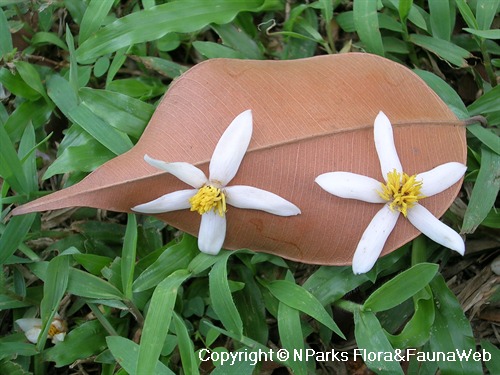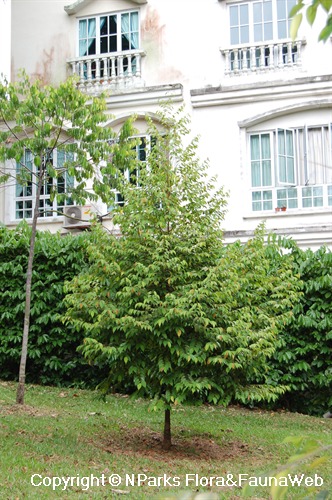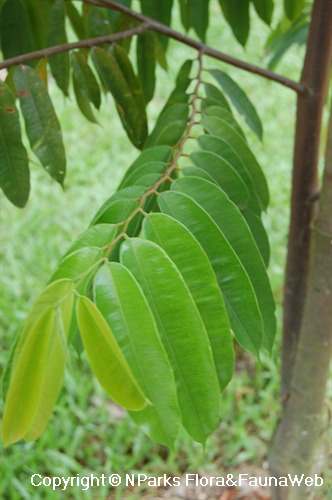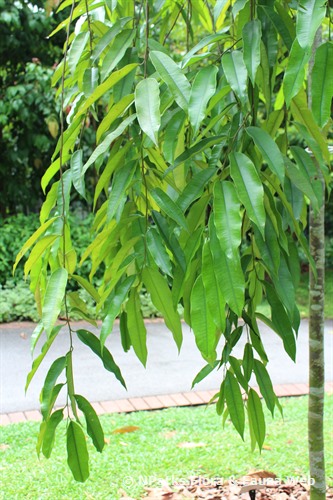
Back
Dryobalanops aromatica C.F. Gaertn.
| Family Name: | Dipterocarpaceae |
| Common Name: | Kapur, Brunei Teak, Borneo Camphor, Camphor Tree |
Name
Classifications and Characteristics
| Plant Growth Form | Tree |
|---|---|
| Mode of Nutrition | Autotrophic |
Biogeography
| Native Distribution | Sumatra, Borneo, Peninsular Malaysia |
|---|---|
| Native Habitat | Terrestrial |
| Preferred Climate Zone | Tropical |
Description and Ethnobotany
| Growth Form | Large tree with resinous wood and buttresses, able to grow up to about 45 m in its natural habitat |
|---|---|
| Trunk | Girth size can reach up to 1.8 m wide, surface fissured. |
| Foliage | Green broadly ovate leaves, coriaceous and alternate arrangement, measuring about 4 - 6 cm long and 2 - 4 cm wide, acumen up to 1.5 cm long, petiole about 0.5 - 1 cm long. |
| Flowers | 5-petaled flowers borne on axillary and terminal panicle inflorescence up to 7 cm long, petals white and oblong, yellow anthers present, stamens 30 and shorter than the style. |
| Fruit | Fruit is a winged nut, consist of 5 wings up to 6 cm long. |
| Habitat | Can be found in lowland rainforest. |
| Etymology | Genus Dryobalanops is from Greek words "dryobalanos which means "acorn" and "ops" which means "like" and they refer to the acorn-shaped fruits. Species aromatica means fragrant and refers to the fragrant resin. |
| Ethnobotanical Uses | Medicinal: Powdered kernel can be taken to treat colic and stomachache. Oil extracted can used to treat rheumatism, headaches, acne, swellings and conjunctivitis. Timber & Products: Wood is used in the construction of boats, furniture and flooring. Cultural / Religious: Heritage Tree : There are currently three individuals of Dryobalanops aromatica listed as Heritage Trees in Singapore. They can be found at Singapore Botanic Gardens. To find out more about these trees, please visit the Heritage Tree Register. |
Landscaping Features
| Desirable Plant Features | Ornamental Flowers |
|---|---|
| Landscape Uses | Parks & Gardens |
Plant Care and Propagation
| Light Preference | Full Sun |
|---|---|
| Water Preference | Moderate Water |
| Plant Growth Rate | Moderate |
| Rootzone Tolerance | Moist Soils, Well-Drained Soils |
| Propagation Method | Seed |
Foliar
| Mature Foliage Colour(s) | Green |
|---|---|
| Foliar Arrangement Along Stem | Alternate |
| Foliar Attachment to Stem | Petiolate |
| Foliar Apex - Tip | Acuminate |
Floral (Angiosperm)
| Flower Colour(s) | White |
|---|---|
| Flower Grouping | Cluster / Inflorescence |
| Flower Location | Axillary, Terminal |
| Inflorescence Type | Panicle |
Fruit, Seed and Spore
| Mature Fruit Colour(s) | Brown, Green |
|---|
Image Repository
Others
| Master ID | 1569 |
|---|---|
| Species ID | 2862 |
| Flora Disclaimer | The information in this website has been compiled from reliable sources, such as reference works on medicinal plants. It is not a substitute for medical advice or treatment and NParks does not purport to provide any medical advice. Readers should always consult his/her physician before using or consuming a plant for medicinal purposes. |



